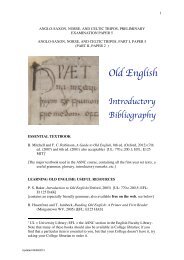Scandinavian history in the Viking age - Department of Anglo-Saxon ...
Scandinavian history in the Viking age - Department of Anglo-Saxon ...
Scandinavian history in the Viking age - Department of Anglo-Saxon ...
Create successful ePaper yourself
Turn your PDF publications into a flip-book with our unique Google optimized e-Paper software.
<strong>Scand<strong>in</strong>avian</strong> History <strong>in</strong> <strong>the</strong> Vik<strong>in</strong>g Age<br />
The colonies<br />
[B830] For <strong>the</strong> British isles <strong>in</strong> general, see: M. Olsen, ‘Runic <strong>in</strong>scriptions <strong>in</strong> Great Brita<strong>in</strong>, Ireland and<br />
<strong>the</strong> Isle <strong>of</strong> Man’, Vik<strong>in</strong>g antiquities <strong>in</strong> Great Brita<strong>in</strong> and Ireland. VI: Civilisation <strong>of</strong> <strong>the</strong> Vik<strong>in</strong>g settlers <strong>in</strong><br />
relation to <strong>the</strong>ir old and new countries, ed. H. Shetelig (1954), 151-232 [UL S592.b.94.19]; M.P. Barnes,<br />
‘Towards an edition <strong>of</strong> <strong>the</strong> <strong>Scand<strong>in</strong>avian</strong> runic <strong>in</strong>scriptions <strong>of</strong> <strong>the</strong> British isles: some thoughts’, NS 29<br />
(1992), 32-42; see also (I47)<br />
[B831] Runic <strong>in</strong>scriptions from <strong>the</strong> isle <strong>of</strong> Man have been edited more recently by R.I. P<strong>age</strong>, see ‘Some<br />
thoughts on Manx runes’, SBVS 20 (1978-81), 179-99 and ‘More thoughts on Manx runes’, Michigan<br />
Germanic studies 7 (1981), 129-37; cf. also (I230 ff.) and for <strong>the</strong> runic crosses more generally (M155 ff.)<br />
[B832] For <strong>the</strong> Scottish isles, A. Liestøl, ‘Runes’, (I121):224-38<br />
[B833] For Ireland, see: M.P. Barnes et al., The runic <strong>in</strong>scriptions <strong>of</strong> Vik<strong>in</strong>g <strong>age</strong> Dubl<strong>in</strong>, National<br />
Museum <strong>of</strong> Ireland medieval Dubl<strong>in</strong> excavations 1962-81 B:5 (1997) [ASNC]<br />
[B834] The <strong>in</strong>scriptions discovered so far <strong>in</strong> ma<strong>in</strong>land Russia tend to be fairly cryptic, or <strong>of</strong>ten pla<strong>in</strong><br />
garbled: A. Liestøl, ‘Runic <strong>in</strong>scriptions’, (J28):121-31; E.A. Melnikova, ‘<strong>Scand<strong>in</strong>avian</strong> runic <strong>in</strong>scriptions<br />
as a source for <strong>the</strong> <strong>history</strong> <strong>of</strong> eastern Europe’, (J55):169-73; J.K. Kusmenko, ‘Zur Interpretation der<br />
Runen<strong>in</strong>schrift auf den Anhänger von Alt-Ladoga’, NOWELE 30 (1997), 181-201<br />
[B835] For England, see: M. Syrett, The Vik<strong>in</strong>gs <strong>in</strong> England. The evidence <strong>of</strong> runic <strong>in</strong>scriptions. ASNC<br />
Guides, Texts, and Studies (2002) [UL 2003.11.1929]<br />
Runic literacy<br />
The guides above (B800 ff.) and studies <strong>of</strong> <strong>the</strong> late Vik<strong>in</strong>g-<strong>age</strong> runestone explosion (C90 ff.) provide<br />
orientation <strong>in</strong> <strong>the</strong> field <strong>of</strong> runic literacy <strong>in</strong> Vik<strong>in</strong>g-<strong>age</strong> Scand<strong>in</strong>avia, which may (or may not) have been<br />
quite extensive; our impressions seem to have been coloured by <strong>the</strong> more widespread casual use <strong>of</strong> runic<br />
script <strong>in</strong> mediaeval <strong>Scand<strong>in</strong>avian</strong> towns.<br />
[B835] A. Liestøl, ‘The literate Vik<strong>in</strong>gs’, (A45):69-78<br />
[B836] C.W. Thompson, ‘Nonsense <strong>in</strong>scriptions <strong>in</strong> Swedish Uppland’, Studies for E<strong>in</strong>ar Haugen<br />
presented by friends and colleagues, Janua l<strong>in</strong>guarum: series maior 59, edd. E. Scherabon Firchow et al.<br />
(1972), 522-34 [UL 779.b.32.59]<br />
[B837] J. Meijer, ‘Corrections <strong>in</strong> Vik<strong>in</strong>g <strong>age</strong> rune-stone <strong>in</strong>scriptions’, ANF 110 (1995), 77-83<br />
[B838] T. Spurkland, ‘Literacy and ‘runacy’ <strong>in</strong> medieval Scand<strong>in</strong>avia’, (O89):333-344<br />
[B839] T. Spurkland, ‘<strong>Scand<strong>in</strong>avian</strong> medieval runic <strong>in</strong>scriptions: an <strong>in</strong>terface between literacy and<br />
orality?’, Roman, runes and Ogham: medieval <strong>in</strong>scriptions <strong>in</strong> <strong>the</strong> Insular world and on <strong>the</strong> Cont<strong>in</strong>ent,<br />
edd. J. Higgit, K. Forsyth, and D. Parsons (2001), 121-28 [ASNC]<br />
Non-runic <strong>in</strong>scriptions<br />
[B840] M. Syrett, The Roman-alphabet <strong>in</strong>scriptions <strong>of</strong> medieval Trondheim. 2 vols. Skrifter for<br />
middelalderstudier; nr. 13 (2002) [ASNC]<br />
Place-names<br />
The study <strong>of</strong> place-names has an immense contribution to make to <strong>the</strong> <strong>history</strong> <strong>of</strong> Vik<strong>in</strong>g-<strong>age</strong> Scand<strong>in</strong>avia;<br />
for some <strong>of</strong> <strong>the</strong> various applications <strong>of</strong> toponomastics, see <strong>the</strong> sections on social organisation (C60 ff.),<br />
cult-sites and paganism (K90 ff.), parishes and early churches (L220 ff.), and settlement patterns (M25<br />
ff.). The discipl<strong>in</strong>e is however a highly specialised one, where little <strong>of</strong> <strong>the</strong> research is conducted outside<br />
<strong>the</strong> <strong>Scand<strong>in</strong>avian</strong> langu<strong>age</strong>s, which makes an <strong>in</strong>itial approach to <strong>the</strong> topic seem ra<strong>the</strong>r forbidd<strong>in</strong>g. For<br />
bibliographical guidance, see:<br />
[B841] G. Fellows-Jensen, ‘Place-name research <strong>in</strong> Scand<strong>in</strong>avia 1960-1982, with a select bibliography’,<br />
Names 32 (1984), 267-324; for <strong>the</strong> Atlantic colonies, see also E.J. Ell<strong>in</strong>gsve, Islandsk navnebibliografi;<br />
Færøysk navnebibliografi (1984) [UL Uc.7.8301]<br />
[B821] P. Larsson, ‘Recent research on personal names and place-names <strong>in</strong> runic <strong>in</strong>scriptions’, Onoma<br />
37 (2002), 46-68<br />
56






